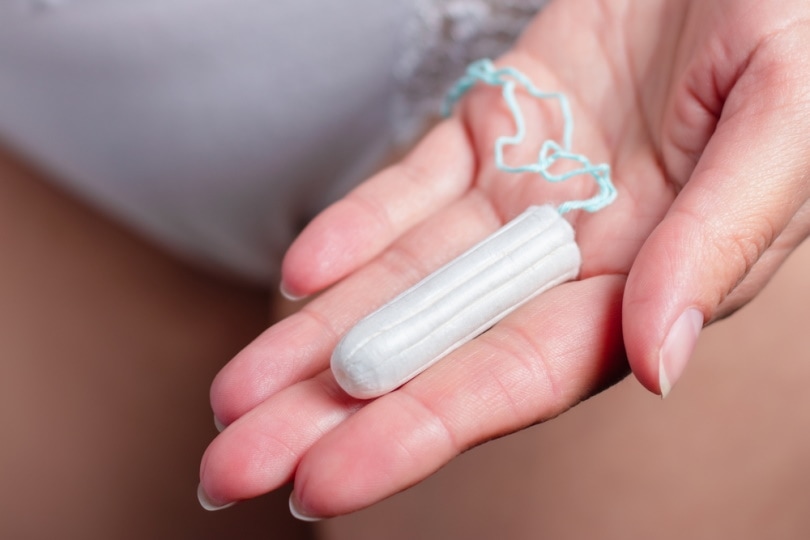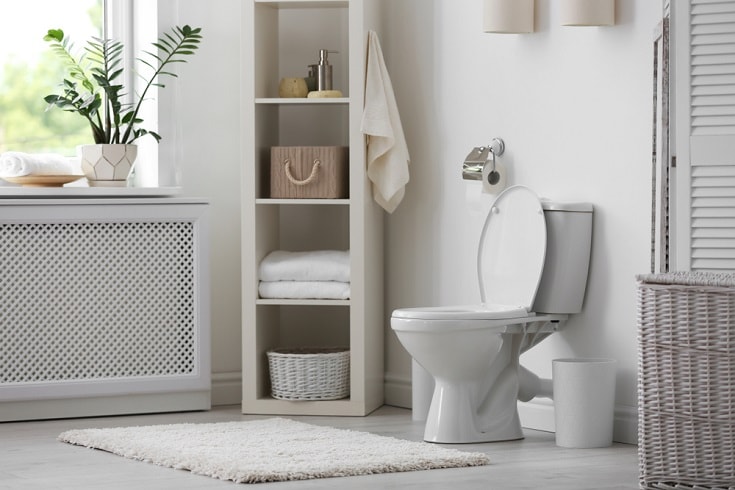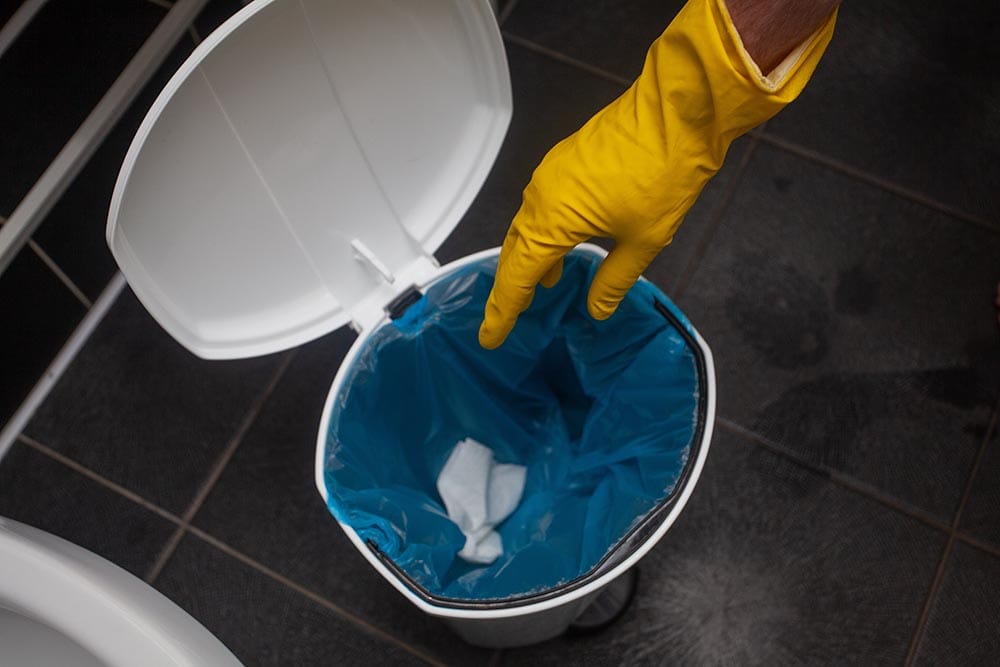Can You Flush Tampons Down a Toilet? Risks, Suggestions, & FAQ
-

- Last updated:

There is no denying that tampons are very beneficial to women all over the world. They made menstrual care products more accessible and expanded the limits of what women can do while on their monthly period. However, women are still debating about whether one should flush tampons down a toilet. Sure, it may be one of the easiest and most convenient ways of discarding menstrual waste products, but it is highly discouraged.
Read on to learn if one can flush a tampon down a toilet and why you shouldn’t. We will also discuss how to get rid of tampons without harming the environment.
To Flush or Not to Flush?
The harsh reality of tampons is that they are made of non-biodegradable plastic, and when flushed down the toilet, they can cause clogs and wreak havoc on sewer systems. Moreover, if the tampons make their way into waterways, they can pollute the environment in unprecedented ways. According to the Environmental protection Agency (EPA), tampons don’t break down as easily as toilet paper, so they easily clog pipes and damage the water treatment infrastructure.
There is still a lot of confusion about the proper way of discarding tampons despite their obvious impact on the environment. Instead of getting bogged down by the myriad two-cent facts making rounds on the internet, we are here to weigh in with the verdict.
While growing up, women were encouraged to flush used tampons down the toilet. It’s the way it was done by their moms and the generation of women before them. Besides being a long-held practice, it is a considerate method of tampon disposal if concerned for the people who clean public restrooms.

First, let us address the elephant in the room. Yes, it is possible to flush a tampon down a toilet. Those who prefer to dispose of used tampons by flushing down the toilet do so because it is easy and convenient. No one wants to walk around with a cotton tube saturated with body fluid until they can find a proper way to dispose of it. Also, most ladies are usually concerned with the unpleasant smell that a used tampon may release when it ends up in the trash bin, especially in a public restroom.
As tempting as it may be to flush your tampons down the drain, experts highly discourage this action because of the potential issues likely to arise. In fact, Tampax, one of the biggest tampon brands in the US, discourages flushing tampons.¹ “Don’t flush down the tampon wrapper or applicator; in fact, don’t flush even the actual tampon,” they advise.
Also, Kotex, another popular brand that produces sanitary products, gives the same advice, albeit more concisely.2 They provide instructions on the label, which declare: “Don’t flush tampons and wrappers down the toilet; you might clog up the plumbing system and it’s bad for the environment. Just wrap it in some toilet paper (or put it in a bag) and place it in the bin or sanitary disposal unit.”
What Happens If You Do It Anyway?
1. They Clog the Toilet
Many women believe they can flush tampons down a toilet, so long as the toilet doesn’t have a septic system. Toilets are usually connected to a larger sewer system, usually managed by the local authority, or connected to a separate sewer system, managed by the owner. Unfortunately, a vast majority of septic systems cannot handle sanitary waste products.
So, some people deem it okay to flush a tampon if the waste goes straight to the larger sewer system. However, even if your home is connected to the local sewer system, flushing the tampons will eventually clog the toilet drainage.
- The main qualities of tampons are expandability and absorbency. On average, tampons absorb fluids about ten times their size. As the tampon absorbs liquids, it expands without breaking away. While this may be a good thing in preventing period leaks, when flushed down a toilet it will take longer to degrade compared to other toilet wastes while traveling through the pipe work. This makes them hard to dissolve and can cause serious plumbing issues, especially in older sewer systems. Clogging can occur even if a tampon is advertised as biodegradable.
- Once the tampon is flushed down the drain, it will keep absorbing liquids for as long as it can without disintegrating. This can even take months. Since about 7 billion tampons are discarded each year, if they pile up in the pipework for months, they will inevitably clog the pipes.3 When sewer systems backup, wastewaters will overflow, most often from manholes. Tampons also create issues in the septic system.

2. Harmful Effects on the Environment
Flushed tampons not only clog up sewer screens, but they can also find their way into waterways such as rivers, lakes, and oceans hence, polluting them. This has raised serious concerns among environmental advocates. In fact, it is estimated that tampons kill approximately 1 million fish every year.4 Another research claims that tampons flushed down the toilet eventually end up in the ocean killing about 20 million to 100 million fish per year.5
We still have no idea how many tampons are flushed down a toilet, so it’s impossible to know their exact effects on the environment. However, these statistics should give you a rough idea of just how dangerous it is to flush your menstrual products down the drain.
Tampons end up in water bodies because many of the sewer systems we use are “combined”. This essentially means that towns and cities are designed to dispose of wastewater or rainwater. Since rainwater is unpredictable, sewers are constructed to allow overflow when there has been too much rainwater for the sewer system to maintain.
However, when rainwater and sewer water are channeled into the same sewer system, they are likely to overflow. So, not only will the stormwater overflow but also everything that was flushed down the toilets, including tampons. These overflows usually make their way into natural water bodies.
Moreover, some sewer systems are designed with choppers and grinders to help toilet wastes move through sewer systems efficiently. As they break down tampons, they create tiny little plastic pieces that enter treatment plants, eventually ending up in natural water bodies.

3. High Maintenance and Repair Costs
Flushing tampons create money issues too. As earlier mentioned, flushing feminine hygiene products down the toilet will likely clog up the sewer system. According to a campaign dubbed “Toilets are NOT Trash Cans”, flushed products such as paper towels, wipes, and menstrual products can “Cause problems for utilities, amounting to billions of dollars in maintenance and repair costs.”6
Every year, the government has to allocate millions of dollars to remove debris flushed down the sewer system. The solid waste that doesn’t leak out to water bodies is usually sent to the landfill. So, flushing tampons down a toilet is just an expensive way of dumping them in the trash. This is because they will eventually end up in the landfill anyway.
Considering the potential issues brought on by flushing tampons down a toilet, we can confidently say that flushing tampons- be it in a public or private restroom – is not the best way to dispose of these feminine sanitary products.

How to Properly Dispose of Tampons
Now that you are aware of the repercussions of flushing tampons down a toilet, what is the best and most environmentally responsible way of disposing of used tampons?
1. Dump Them in a Garbage Can
There is a good reason why there are little trash cans in women’s restrooms. Since most commercial tampons are made from cotton, rayon, and plastic, they should be discarded in a trash bin. To properly dispose of the tampon, wrap it up in tissue, then trash it in the bin. If you are in a public toilet, it’s best to discard the tampon in a sanitary napkin bin for proper disposal.

2. Compost the Tampon
If you use all-natural and organic tampons that are made from cotton, you could also consider composting them. However, look at the tampon’s brand label for the material information if unsure. Tampons that are 100% cotton can be added to home compost; typically, they take five to six months to disintegrate. According to Natracare, menstrual blood on the tampon is in fact a great addition to the compost.7 This is because it contains sodium, iron, and phosphates, which are ideal for plant fertilizer.

Conclusion
People carelessly flush millions of tampons down the toilet without thinking about the ramifications of their actions. Even though you can flush a tampon down a toilet, you absolutely should not! Not only can most commercially-sold menstrual products clog up public sewer systems, but they can also harm the environment once they end up in waterways and oceans.
Clogged toilets will also push up public bills for repair and maintenance services and create sewerage problems such as overflows. Instead of flushing tampons during your time of the month, consider wrapping them up in a tissue and popping it in a garbage bag. Alternatively, compost the tampons if they are made from biodegradable materials such as 100% cotton.
Featured Image Credit: Skrypnykov Dmytro, Shutterstock
Contents

